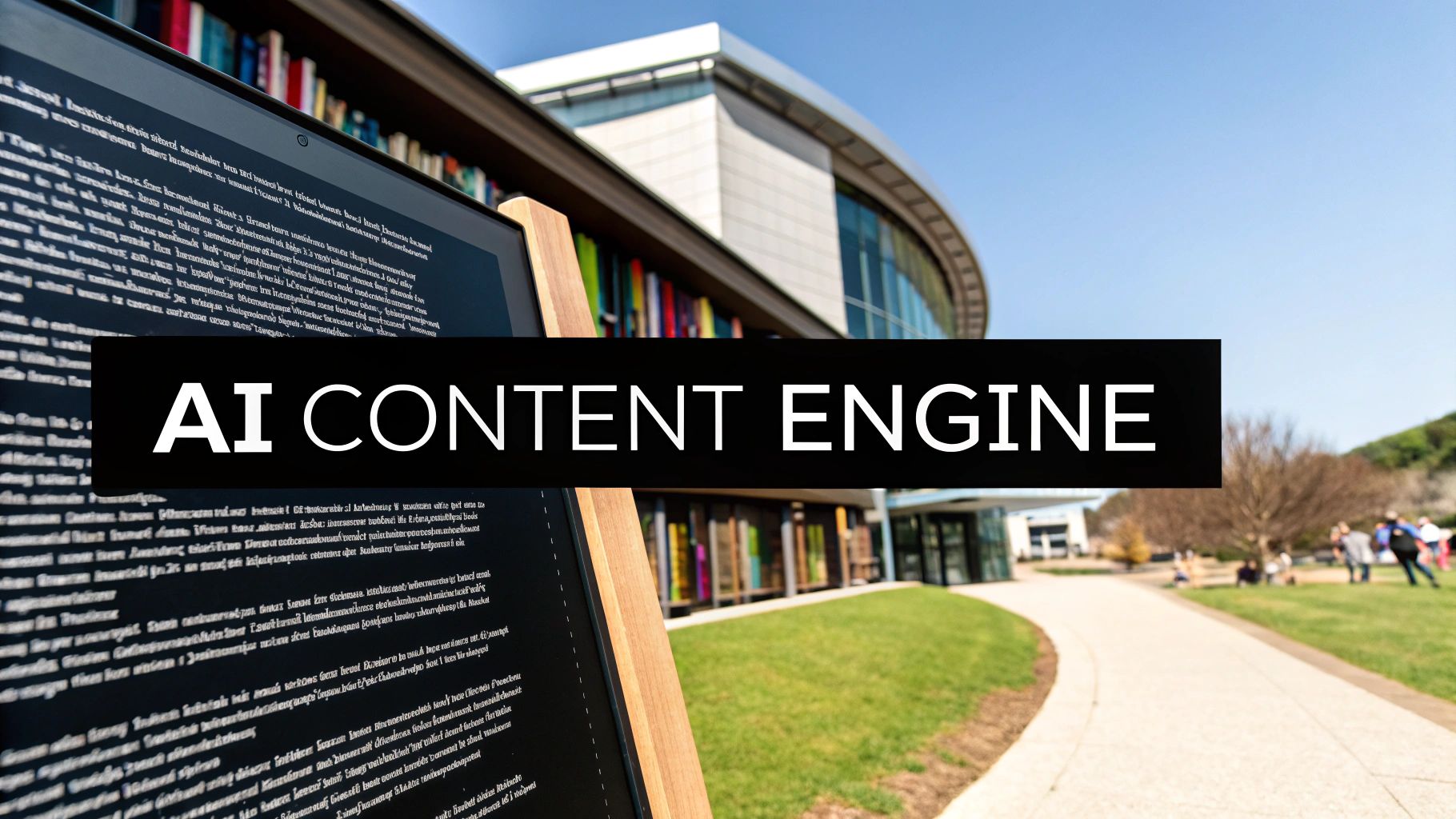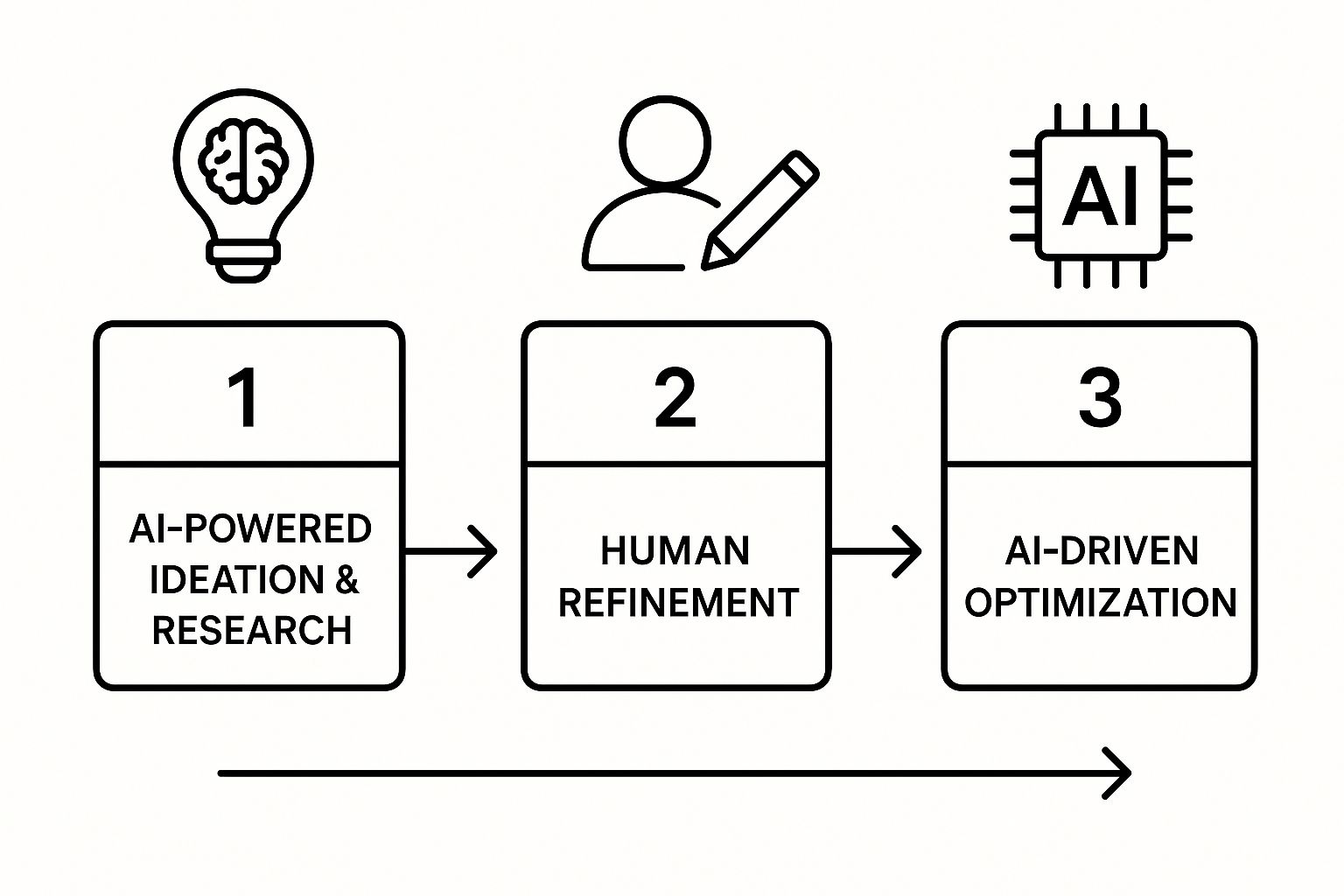
Transform Content Strategy with AI Powered Content Creation
Explore how AI powered content creation can boost your content strategy. Learn proven tools and workflows to produce high-quality content efficiently.
Welcome to a new way of creating content. Artificial intelligence isn't here to replace human creativity—it's here to be its most powerful collaborator.
Think of AI-powered content creation like having a brilliant assistant who handles all the tedious work for you. It takes on the heavy lifting of research, drafting, and number-crunching, freeing you up to focus on what really matters: strategy, brand voice, and genuine human insight.
The New Era of AI Content Collaboration
Let's get one thing straight: the fear of AI replacing writers is already outdated. It's much more useful to see this technology as a force multiplier for your own skills. It automates the repetitive, soul-crushing parts of the job, which leaves you to do what you do best—think critically, tell great stories, and connect with your audience.
This collaborative dynamic is already making waves. Companies in marketing, media, and e-commerce are using AI to pump out personalized content faster than ever before. This guide is your roadmap to doing the same, turning your manual grind into a smart, strategic operation.
Shifting From Manual Labor to Strategic Oversight
The real change here is moving from doing everything to directing everything. Your role evolves from a lone creator to more of an editor-in-chief, guiding the AI to bring your vision to life.
What does that look like in practice? It means getting more done with the same resources. A single person can now tackle tasks that used to require a whole team.
- Brainstorm dozens of blog topics in minutes, not hours.
- Generate solid first drafts for articles, social media posts, and even video scripts.
- Analyze performance data to spot content gaps and figure out what your audience wants.
- Repurpose a single webinar into a complete multi-channel campaign without breaking a sweat.
"The future of AI is not about replacing humans, it’s about augmenting human capabilities."
This shift is fueling some serious growth. The AI content creation market is projected to hit USD 2563.29 million in 2025 and is expected to explode to USD 10,593.0 million by 2033. That surge shows just how much demand there is for high-quality, efficient content across the board. You can dive deeper into these numbers over at GrandViewResearch.com.
This image from Wikipedia gives a nice, clean overview of how different generative AI models turn a prompt into a finished product, whether it's text or an image.

It all starts with a human. You give the AI model a prompt, and it interprets that instruction to generate something entirely new.
This is where a platform like ViewPrinter comes in. It brings this entire collaborative workflow under one roof, integrating AI for media creation, writing, and scheduling. It’s all about blending your strategic direction with AI’s tactical firepower, and this guide will show you exactly how to do it.
How Generative AI Actually Creates Content

To really get the most out of AI, it helps to peek behind the curtain and see how it works. Don't worry, this isn't a deep dive into code. It's just a simple look at the magic that turns your ideas into finished content.
The engine driving all of this is something called a Large Language Model (LLM). Imagine you combined a massive digital library with the world's smartest predictive text. That's an LLM. It’s been trained on an unbelievable amount of data—trillions of words, images, and code snippets scraped from the internet.
Through that training, the AI learns more than just facts. It starts to understand the patterns of human communication—grammar, context, tone, and even the creative flair that makes writing compelling.
The Three-Step Generative Process
When you use generative AI, it's really just a simple, three-step conversation between you and the machine. Your instructions are the starting point, and the AI builds from there.
- Input (The Prompt): It all starts with you. You give the AI an instruction, called a prompt. This could be a simple question, a detailed command to write a blog post, or a description of an image you have in your head.
- Processing (The Black Box): The LLM takes your prompt and instantly cross-references it against all the patterns it learned during training. It then predicts the most logical sequence of words or pixels to deliver what you asked for.
- Output (The Creation): The AI generates something completely new—text, an image, or even a video—that matches your prompt.
This isn’t just a fancy copy-and-paste job. The AI is truly generating original work based on its deep understanding of language and concepts. For a deeper look, checking out a practical explainer on what generative AI is can fill in the gaps.
Different Models for Different Tasks
Not all AI is created equal. Different models are built for different jobs, and knowing the difference helps you pick the right tool for the task at hand.
Generative AI is not a single entity but a category of technologies. A text model like GPT-4 excels at writing, while an image model like DALL-E 3 specializes in visual creation. The key is matching the model's strength to your creative goal.
Platforms like ViewPrinter make this easy by bundling the best models into one place. You don't have to worry about which AI does what; the platform just picks the right engine for the job, whether you're writing ad copy or designing a social media graphic.
Here’s a quick breakdown of the main types you'll use:
- Text-to-Text Models: These are the workhorses for anyone creating written content. You give them a text prompt, and they write back. Think blog posts, emails, social media captions, and scripts.
- Text-to-Image Models: These tools are visual magicians. They turn your written descriptions into one-of-a-kind images. Perfect for custom blog headers, ad visuals, or social media posts—no designer needed.
- Text-to-Video Models: This is a newer but incredibly powerful category. These models create short video clips from your text descriptions, making them great for social media content, product demos, or animated explainers.
Once you get this basic framework, you stop being a passive user and start becoming a director. You’re the one guiding the AI to create exactly what you need.
So, Why Is AI Actually a Game-Changer for Content Workflows?

It’s one thing to understand how generative AI works on paper, but it’s another to see it completely reshape your daily to-do list. Bringing AI powered content creation into your process isn't just a small tech upgrade. It fundamentally changes how work gets done, unlocking a level of productivity that used to feel impossible for most teams.
The first thing you'll notice is a massive efficiency boost. AI eats up the repetitive, soul-crushing tasks that drain your creative energy—things like resizing dozens of images, drafting social media variations, or transcribing an hour-long interview. By handing off that grunt work, you and your team are free to focus on what actually matters: strategy, connecting with your audience, and thinking about the big picture.
This newfound freedom almost always leads to a higher output of quality content. All of a sudden, a single person can manage a workload that once required an entire team, without sacrificing quality or hitting burnout.
From Blank Page to Full Campaign in Minutes
We’ve all been there, staring at a blank page, waiting for inspiration to strike. AI is the ultimate cure for writer's block. It acts as a creative partner, generating a flood of fresh ideas, unique angles, and snappy headlines in seconds.
Instead of spending hours in a brainstorming session that goes nowhere, you can give an AI a simple prompt and get back a dozen different directions to explore. This collapses the distance between ideation and execution, turning a slow, manual grind into a fast-paced, collaborative dance.
Here’s a real-world example: your team just wrapped up a one-hour webinar. In the old days, turning that into more content was a multi-day project.
- Manually transcribe the audio.
- Dig through it for good quotes for social media.
- Write a summary blog post.
- Draft an email to send to attendees.
With AI, that entire workflow shrinks to under an hour. A good tool can transcribe, summarize, and then spin up a complete multi-channel campaign from that single webinar. You just guide the process. You can learn more about how AI marketing automation transforms these exact workflows in our guide.
Finally, Consistency and Personalization at Scale
Keeping a consistent brand voice across hundreds of posts and a half-dozen platforms is a huge headache. AI helps solve this by learning your unique tone, style, and vocabulary, making sure every piece of content sounds like it came from the same brain.
This consistency is what builds trust and brand recognition. But at the same time, AI makes it possible to deliver hyper-personalized content on a scale that was never humanly possible. It can tweak messaging for different audience segments, creating more meaningful connections and driving way better engagement.
This ability to both streamline work and personalize outreach is why the market is exploding. The AI in marketing sector is already valued at $47.32 billion and is on track to blow past $107.5 billion by 2028.
That kind of growth tells a clear story: businesses are pouring money into AI because it flat-out works.
And that’s where platforms like ViewPrinter come in. We’re building these AI tools directly into the content creation workflow so you don’t have to jump between a dozen different apps.
With ViewPrinter, you can generate ideas, create graphics, write copy, and schedule it all from one spot. This unified approach doesn't just save time—it makes sure your entire content strategy is airtight from start to finish.
Building Your AI-Assisted Content Workflow
So, you get the what and why of AI in content. But the real magic happens when you put it into practice. Using AI-powered content creation isn't about flipping some magic switch; it’s about building a smart, repeatable system where the tech serves your strategy, not the other way around.
The best way to do this is with a “human-in-the-loop” model. Think of yourself as a film director. The AI is your camera crew, your lighting team, your editors—they handle the technical heavy lifting. But you provide the vision, guide the story, and make the final creative calls. This partnership ensures the end result is not only cranked out quickly but is also authentic and strategically on-point.
A clear workflow stops you from just making noise. It turns AI into a reliable partner that helps you hit real business goals, whether that’s boosting engagement or driving sales.
Stage 1: AI-Powered Ideation and Research
Every great piece of content starts with a solid idea. Traditionally, this meant hours spent digging through analytics, spying on social trends, and getting lost in keyword research spreadsheets. AI shrinks this whole process from hours into minutes.
You can point an AI at huge datasets to instantly spot trending topics, find customer pain points, or see content gaps your competitors are completely missing. For instance, you could ask an AI to "identify the top 5 questions e-commerce store owners have about TikTok marketing" and get a prioritized list back in seconds. This data-first approach makes sure your content is relevant and genuinely helpful right from the get-go.
Stage 2: AI-Assisted Outlining and Drafting
Once you’ve locked in a topic, it's time to build a skeleton. An AI can instantly generate a comprehensive outline for a blog post, a video script, or even a social media carousel. It helps organize your thoughts into a logical flow, complete with headings, subheadings, and key talking points.
With the outline approved, you can hand off the first draft to the AI. This is probably the biggest time-saver of all. The AI produces the baseline text, filling in the structure and saving you from that dreaded "blank page" stare. The goal here isn't perfection; it's momentum. You get a solid foundation—around 70-80% complete—that you can then elevate with your own expertise.
Stage 3: The Crucial Human Touch
This is, without a doubt, the most important part of any AI-assisted workflow. An AI draft is just a starting point, not the finished article. This is where you inject what the machine can't: personality, real-world experience, and genuine storytelling.
This infographic breaks down the core stages of a balanced workflow, showing how AI execution and human oversight work hand-in-hand.

As you can see, human refinement is the central pillar that guarantees quality and authenticity before you move on to the final tweaks.
During this stage, your job is to:
- Fact-check all claims and stats for accuracy. AI can hallucinate!
- Inject your brand voice and unique stories to make the content connect.
- Add original insights and opinions that provide real, human value.
- Smooth out the flow and readability to create a great experience for the reader.
This back-and-forth is what creates high-quality, trustworthy content that actually resonates with people and builds your authority.
To help visualize this partnership, here's a simple breakdown of how the roles are divided at each stage of a typical workflow.
AI-Assisted Content Creation Workflow
| Stage | Human Creator's Role (Strategic Input) | AI Tool's Role (Tactical Execution) | | --- | --- | --- | | Ideation | Defines audience, goals, and strategic focus. Asks the right questions. | Analyzes data, identifies trends, suggests relevant topics and keywords. | | Outlining | Reviews the proposed structure, ensuring it meets strategic intent and reader needs. | Generates a logical outline with headings and key points based on the topic. | | Drafting | Provides key insights, brand-specific examples, and unique data points. | Writes the first draft, populating the outline with foundational text. | | Refinement | Edits for voice, tone, and accuracy. Adds personal stories and expert opinion. | - | | Optimization | Sets the SEO and distribution strategy. Defines target channels. | Suggests headlines, generates meta descriptions, and writes social media copy. |
This table clearly shows that the human is always in the driver's seat, providing the "why," while the AI handles the "how" with speed and efficiency.
Stage 4: AI-Driven Optimization and Distribution
After your team has polished the core content, AI can jump back in to handle the final touches. This is where it really shines, making small, data-driven improvements that can have a big impact on visibility and engagement.
Use AI to brainstorm a dozen headline variations, write compelling SEO titles and meta descriptions, or draft promotional snippets for social media and email. This ensures every piece of the puzzle is fine-tuned for performance. To see this in more detail, check out our complete guide on building a modern content creation workflow.
By following this balanced, multi-stage process, you get the best of both worlds. You get the incredible speed of AI without sacrificing the quality, creativity, and strategic thinking that only a human can provide. Platforms like ViewPrinter are built around this idea, integrating these steps into a single, seamless interface to take you from first thought to final post.
Picking the Right AI Tools for the Job
Stepping into the world of AI powered content creation can feel like walking into a massive hardware store for the first time. There are countless tools on every aisle, all promising to make your project easier. It’s overwhelming. But here’s the secret: you don't need to find the one "best" tool. You need to build a toolkit.
Think about it. You wouldn't use a sledgehammer to hang a picture frame. You need a hammer, a saw, and a screwdriver for different tasks. AI tools are the same way. The best tool for you depends entirely on what you’re trying to create—a blog post, a viral video, or a stunning social media graphic.
Breaking it down this way cuts through all the marketing hype. Instead of getting lost in features, you can focus on what you actually need to do. Are you a writer? A designer? A video editor? Let's find the right tools for your specific workshop.
AI Writing Assistants for Text-Based Content
If words are your trade, AI writing assistants are your new best friend. These aren't just fancy spell-checkers; they're creative partners that help you brainstorm ideas, draft entire sections, and polish your final copy until it shines. They're the cure for the dreaded blank page.
Tools like Jasper and Copy.ai are masters at generating first drafts. You give them a simple prompt—the topic, the tone, the target audience—and they spin up a blog post, a social media caption, or an email newsletter in seconds. You can learn a lot more by checking out a list of the best AI copywriting tools.
- Ideal Use Cases: Creating blog outlines, drafting social media updates, writing A/B test ad copy, and smashing through writer's block.
- Best For: Bloggers, copywriters, and marketers who need to produce a high volume of quality text without burning out.
AI Image Generators for Stunning Visuals
Let's be real: visuals grab attention. But not everyone is a graphic designer. AI image generators have completely leveled the playing field, letting anyone create beautiful, original images from a simple text description. No more endless scrolling through cheesy stock photos.
Platforms like Midjourney and DALL-E 3 are leading the charge here. You can literally type "a photorealistic image of an astronaut drinking coffee on Mars" and get exactly that. This is perfect for custom blog headers, one-of-a-kind social media posts, and ads that people actually stop to look at.
The real magic of AI image generators is the ability to create visuals that perfectly match your brand and message. This creates a level of visual cohesion that used to cost a fortune and take weeks to achieve.
AI Video Creators for Dynamic Media
Video is king of engagement, but it’s always been expensive and complicated to produce. AI video creators are flipping that script. Now, you can generate professional-looking videos from text, images, or existing clips without ever touching a camera.
Look at tools like Synthesia and RunwayML. Synthesia lets you create videos with realistic AI avatars just by typing out a script—perfect for corporate training or quick announcements. Other tools can turn a blog post into a snappy summary video or chop up longer footage into engaging social media reels. We dig deeper into these in our guide to AI content generation tools.
This isn't just a fleeting trend. The global AI market hit $279.22 billion in 2024 and is expected to explode to $1.81 trillion by 2030. That growth shows just how deeply these tools are becoming a part of our daily creative work.
This is exactly why platforms like ViewPrinter exist. Instead of patching together a dozen different subscriptions for writing, images, and video, ViewPrinter brings all these capabilities under one roof. You can generate text, design visuals, and produce video content all in one place, making your entire workflow smarter, not harder.
The Future of AI-Powered Content Creation
The world of AI-powered content creation is moving incredibly fast. What seems like science fiction today will be the standard tomorrow. Looking ahead, a few key shifts are poised to completely change how we create campaigns, connect with people, and even think about our daily workflows.
The future isn't just about having more tools. It's about working with smarter, more connected, and deeply personal technology.
One of the biggest changes is the move toward hyper-personalization on a truly individual level. Imagine an AI creating a unique version of a blog post or social ad for every single person who sees it. It could tweak the tone, images, and call-to-action in real time based on their browsing history and past interactions.
This isn't just basic audience segmentation; it's creating a market of one. It’s about delivering content that feels like it was made just for them.
The Rise of Multimodal AI
Another massive leap is the arrival of multimodal AI. In the past, you needed one tool for text, another for images, and a third for audio. Soon, a single AI model will be able to understand and generate all of these from one simple prompt.
You could just ask it to, "Create a 30-second video ad for our new product, including an energetic script, a synth-pop soundtrack, and visuals of people enjoying it at the beach." The AI would then write the script, compose the music, and generate the video clips. You’d get a complete, campaign-ready asset in minutes.
This jump from single-task tools to integrated, multimodal creators will break down the walls between different types of content production. It allows for truly cohesive campaigns where the visuals, text, and audio are all born from the same creative spark.
This kind of integration will make building a consistent brand experience faster and more seamless than ever before.
AI Embedded in Your Core Platforms
Finally, AI is moving out of standalone apps and becoming a core feature inside the software we already use every day. Think of your CMS, marketing automation tool, or social media scheduler having powerful generative AI built right in.
You won't have to constantly switch tabs to generate copy or design an image. The tools will be right where you need them, when you need them.
This has some huge practical benefits:
- Smarter Workflows: Your CMS could automatically suggest SEO tweaks or generate social media posts the second you publish a new article.
- Seamless Creation: Platforms like ViewPrinter are already doing this, putting AI for text, images, and video directly inside the scheduling and automation interface.
- Data-Driven Suggestions: The AI will see your platform’s performance data, letting it make smarter recommendations based on what’s already working for you.
Ultimately, the future of AI-powered content creation is all about deep collaboration and effortless integration. As these technologies become more personal, versatile, and embedded in our daily tools, they’ll free us up to focus less on the manual work and more on the big-picture strategy that actually connects with people.
Common Questions About AI Content Creation
Diving into AI for your content naturally stirs up a few questions. It’s smart to think about the practical and ethical side of things before you jump in. Let's clear the air on some of the most common concerns.
Will My Content Get Flagged for Plagiarism?
This is probably the biggest worry, and for good reason. The last thing you want is to publish something that isn’t original.
The safest way to use AI is to treat it like a very fast, very capable assistant—not the final author. Think of its output as a solid first draft. Your job is to step in, infuse it with your unique brand voice, add your own insights, and fact-check everything. Always run it through a plagiarism checker before you publish. This way, you get the speed without sacrificing originality.
Will Using AI Content Hurt My SEO?
Another big one. Will Google penalize you for using AI? The short answer: no, not if you do it right.
Google has been very clear that they reward high-quality, helpful content, no matter how it’s made. The focus is on creating content for people, not just for search engines.
The real issue is intent. If you’re using AI to churn out hundreds of low-effort, spammy articles, you’re going to have a bad time. But if you’re using it as a tool to help you research, write, and polish genuinely helpful content for your audience, you’re in the clear.
Good content is good content. As long as your work is valuable and answers a real human's question, it doesn't matter if an AI helped you get there.
What's the Best Way to Start?
It’s easy to feel overwhelmed by all the tools and possibilities. The trick is to start small. Don't try to change your entire content process overnight.
Instead, find one single task that’s repetitive and eats up your time. Maybe it’s brainstorming a week's worth of blog titles. Or maybe it’s writing five different hooks for a social media post.
Pick one AI tool and use it for just that one thing. Once you get comfortable and see how much time it saves, you can start exploring other ways to bring AI into your workflow. This step-by-step approach makes it easy to adopt and proves its value right away.
Ready to bring AI into a workflow that just works? ViewPrinter pulls your ideation, media generation, writing, and scheduling into one place. It’s time to build a smarter content strategy from the ground up. Start creating faster at ViewPrinter.